Making Rigó Jancsi

This cake is so scandalous I can’t even write a headline about it that doesn’t seem obscene. “Preparing Rigo Jancsi”? Not much better. Guess I just have to accept the snickers from the back of the bus and move on.
A good piece of Rigó Jancsi — there I did it again — is essentially a cube, about two inches on a side. It’s all you need since this really is decadent stuff. It’s chocolate mousse, essentially, between two layers of intensely chocolate-y (to the point of being almost coffee-like) spongecake, topped by a layer of chocolate, almost like a softened bittersweet bar.
What’s unusual about this cake is that even though the chocolate is delivered in three different guises, the impression you get is of bare naked cacao. That’s partly a factor of its relatively low sugar content. The rest I’ll credit to gypsy magic. Start your cake by preheating your oven to 350. Next, apply butter or cooking spray to a half sheet pan that’s covered with a sheet of parchment paper.
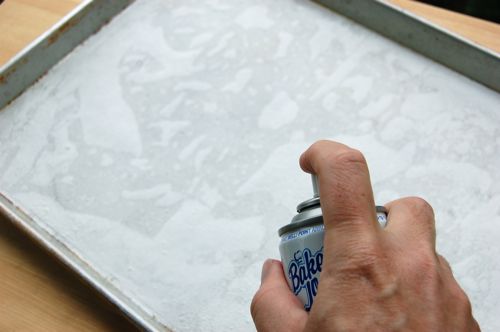
Now begin the spongecake. Melt the butter in a microwave and add the chocolate.
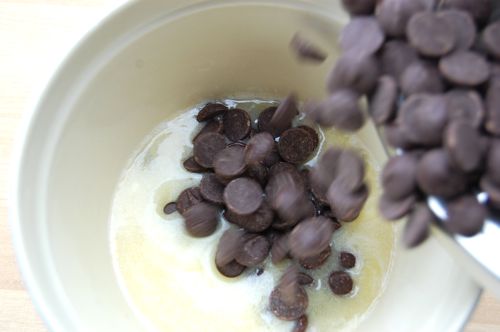
Stir until it’s melted, zapping it for 5-10 seconds as necessary, then set it aside to cool. You want a pudding-like consistency in the end, something like this:
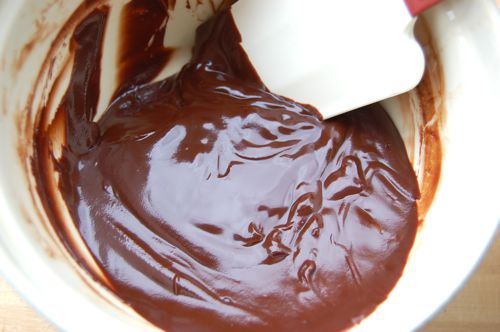
Combine the flour and cocoa in a small bowl and set it aside while you turn your attention to the eggs.
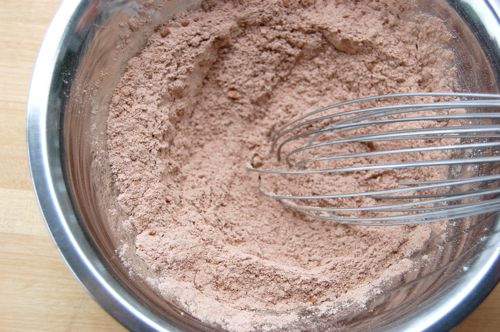
Pour the room-temperature yolks into in the bowl of a mixer fitted with a whip.
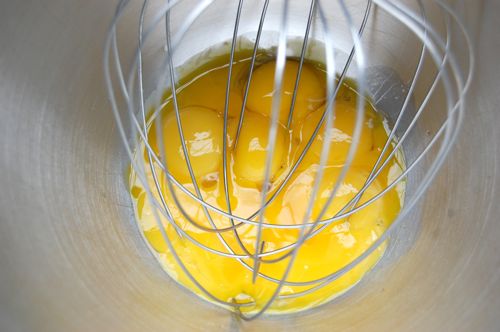
Whip them for about three minutes until they’re pale, and with the machine running, add half the sugar in a steady stream.

Whip 2-3 more minutes until the mixture is good and thick. Scrape it into a medium bowl.
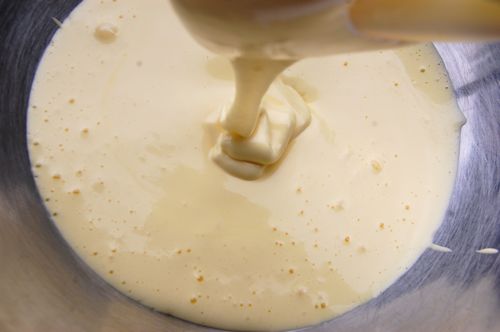
Add the chocolate (zap it for a couple of seconds first it’s too firm)…
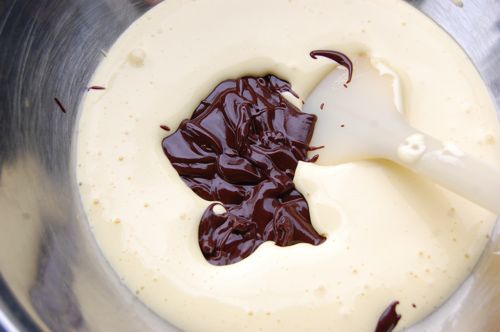
…and fold the two together. Leave some streaks, you don’t want to overdo it.
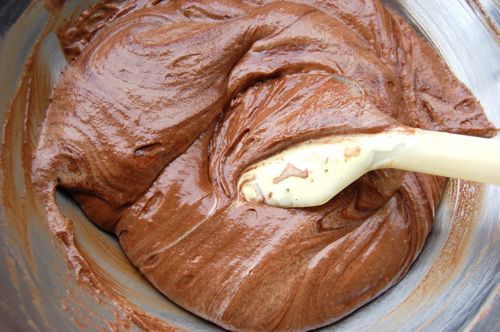
Now all you need is your egg white foam. Rise the mixer bowl and whip (without getting too uptight about it) and pour in the room-temperature whites. Add the salt.
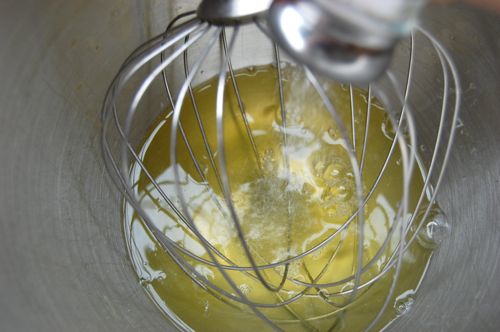
Whip to soft peaks, then add the rest of the sugar in a steady stream.

Continue and whip to stiff peaks. You want them nice and glossy.
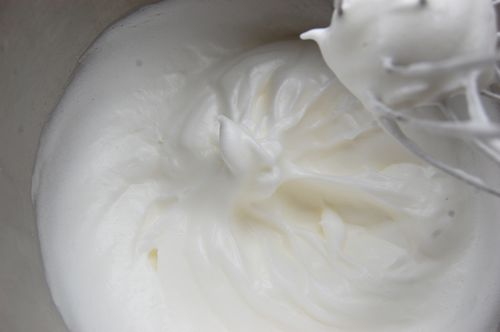
Now to bring everything together. Plop a third of the whites on top of the yolk/chocolate mixture…
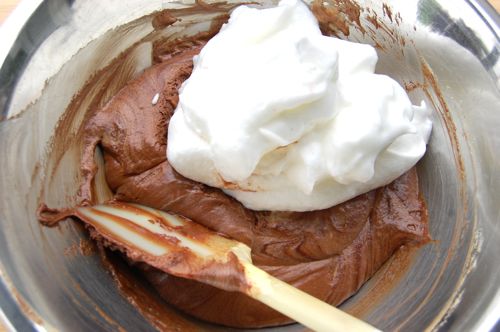
…and simply stir it in.
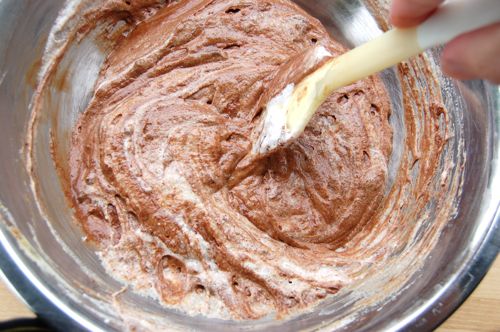
Now fold in the next third.
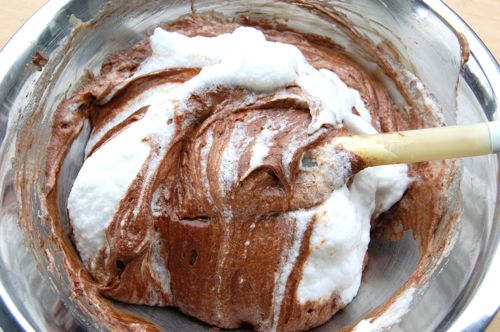
The final third you won’t fold in all the way, because you’re going to sprinkle on your cocoa and flour mixture for the last few strokes.
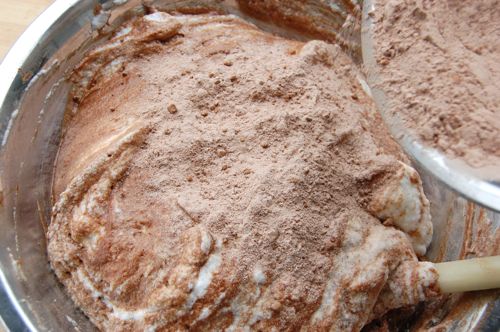
There, all done. Leave some streaks, remember.
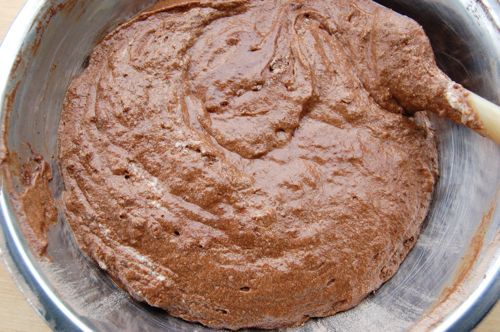
Now scrape the batter into the pan you prepared at the beginning. Get fussy with this step, since you want the batter as even as you can reasonably get it.
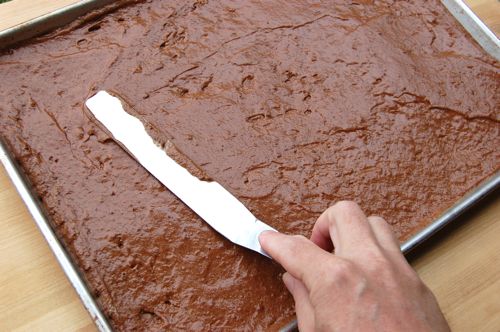
Bake the batter for 12-15 minutes, until the cake starts to pull away from the sides.

Help the rest of the cake release by applying a knife or spatula to the edges.
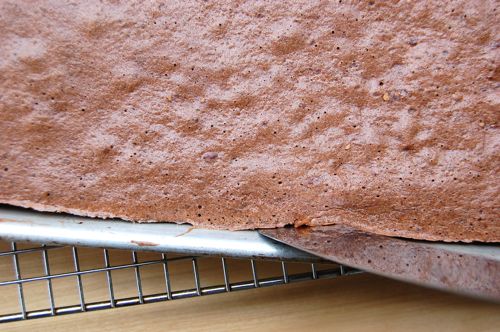
Gently run an icing spatula under the layer to make sure it will release when you turn the pan over.
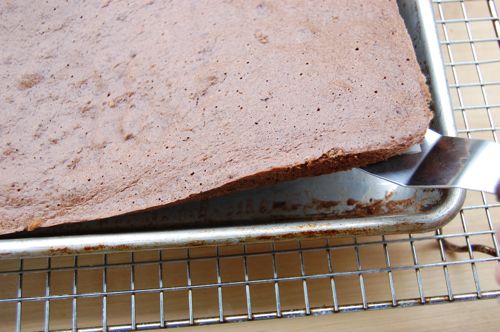
Apply sheet of parchment and a rack to the top of the layer…
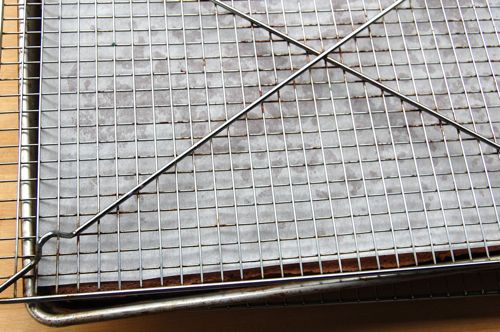
…then flip the whole works over. Remove the pan.
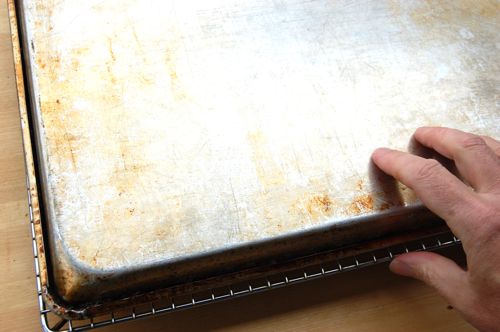
And the parchment. Yes, you’ll lose a film of cake.
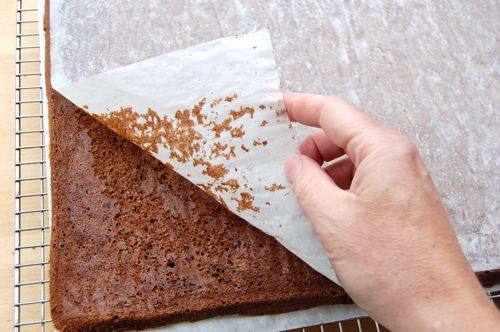
Apply a different sheet of greased parchment plus another rack.
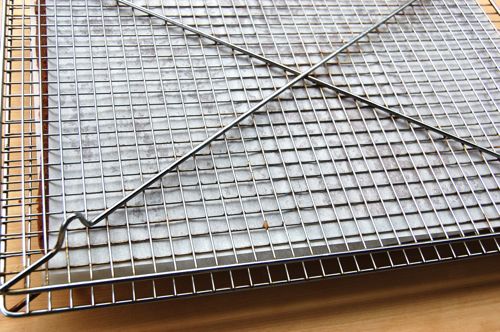
Flip everything over again and remove the first rack and parchment sheet. Yes, you’ll lose some of the top crust in the process. Allow the layer to cool. (Don’t let chocolate-crazed squirrels get it, as they almost did this one). Once the layer is room-temperature, cut the cake sheet in half with a serrated knife. Once the cake is cut, use scissors to cut the underlying parchment paper sheet. Having each half on paper makes them a lot easier to work with.
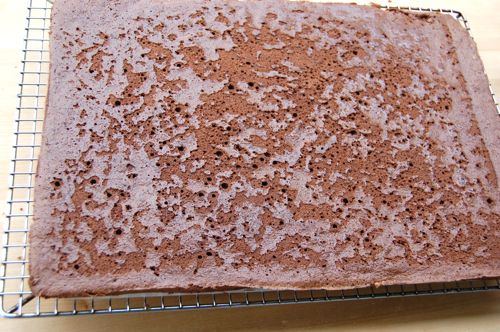
Now prepare the glaze. Combine the butter and chocolate in a microwave-safe bowl and zap on high in ten-second bursts until the chocolate it almost melted, then simply stir, letting the residual heat finish the job.
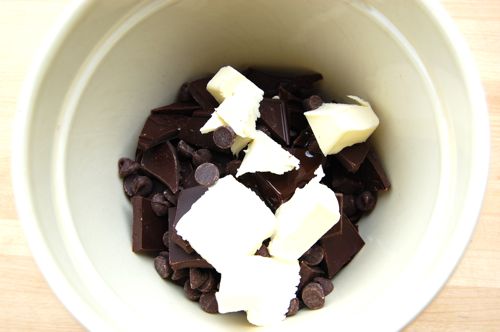
Stir in the vanilla…

…and while it’s still liquid and spreadable, apply the glaze to whichever layer you’ve selected as the top half of your cake. It need not be perfectly smooth. Get the sides if you like.
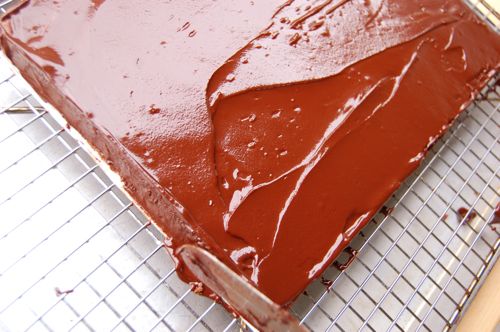
Allow the top to set for about an hour or refrigerate it for ten to fifteen minutes. Then using a long chef’s knife that you’ve heated under hot tap water and dried, score the top into twenty 2″ squares. Wipe the knife, re-warm it and dry it, then cut clean through the layer, separating the pieces. (You’ll need to wipe, warm and dry after each cut to keep the edges clean). Store those in the fridge until needed. There’ll probably be some excess when you’re done. Hide that away for a later coffee break.
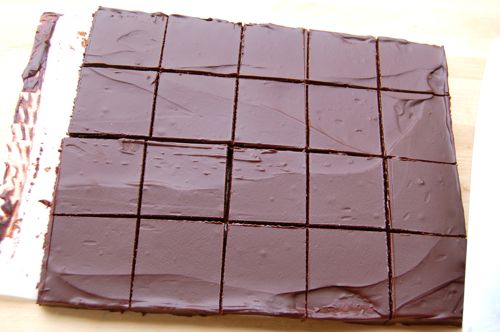
Last is the filling. Combine the powdered sugar and cocoa in a small bowl…
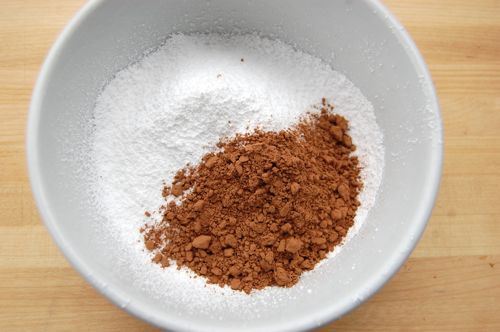
…and whisk them together. Oops, spilled some.
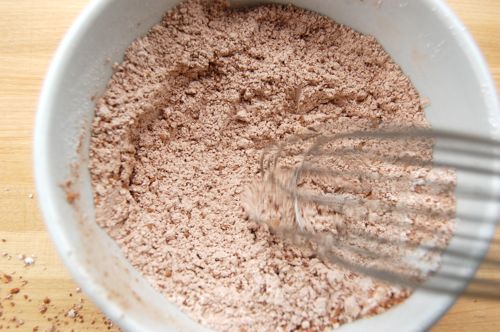
Melt your chocolate using the microwave method and allow it to cool to the same pudding-like consistency as before.
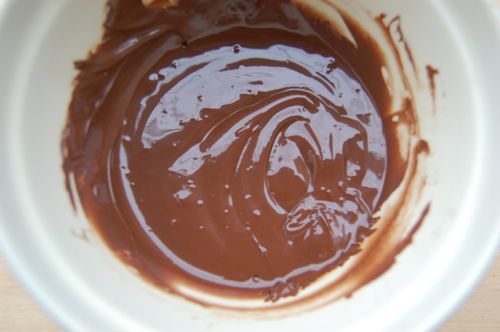
When the chocolate is only barely warm, whip the cream.
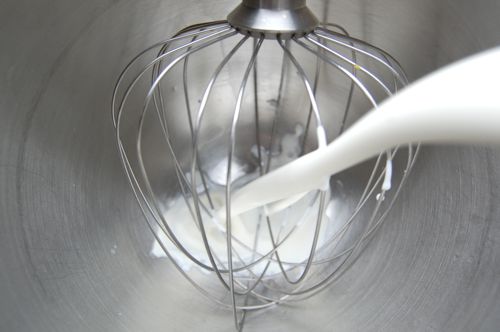
Whip it to just shy of soft peaks, and with the machine running, sprinkle in the cocoa/sugar mixture.

Whip for about fifteen seconds, then add the vanilla and rum.

Lastly, add the chocolate all at once and whisk it in by hand. This will give you more control and help keep you from over-whipping the cream.
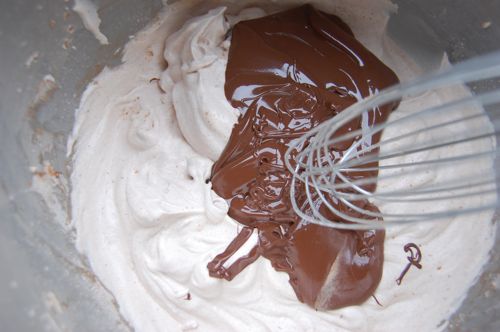
The result will be a thick mousse-like filling. Were I to do this again, I think I would have allowed the cream to sit for five minutes to warm a tad, then dumped it onto the chocolate. That might have helped the chocolate to incorporate a bit better. As it was, I got lots of little flecks of chocolate in the filling. This is entirely normal with this sort of quickie chocolate mousse, however I think the flecks can be minimized.
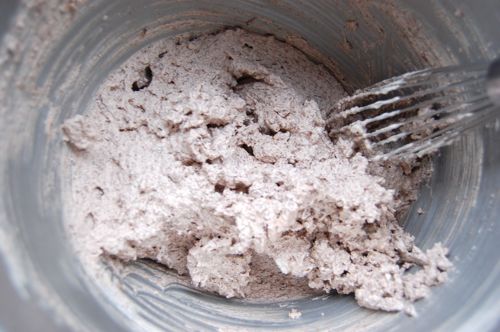
But no matter, I think the little bitty chocolate shavings actually made the texture more interesting. They’re there and then a moment later they’re not, since they melt so fast in your mouth. Anyway, apply a sheen of apricot glaze to the bottom layer, then heap on the filling.
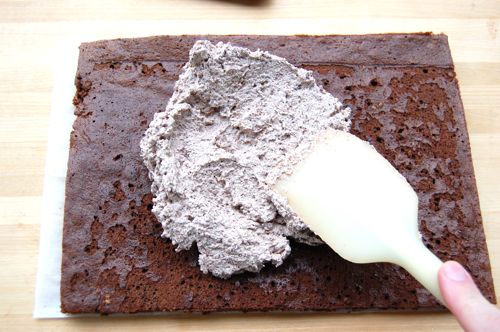
Get fussy with this step too. Being so thick the filling will sculpt well. Make sure it’s even. Square the edges…
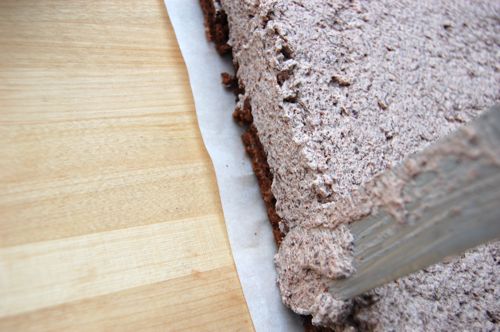
…and don’t forget those corners. Take as much time as you need to get it perfectly even.
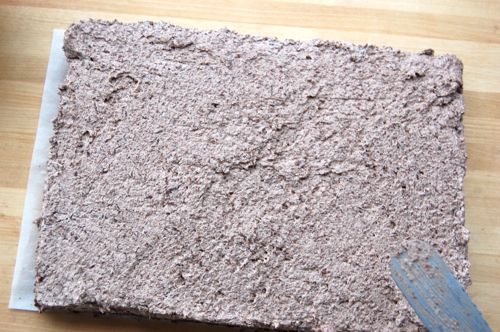
Then put the top pieces back on and refrigerate the whole thing for at least an hour.
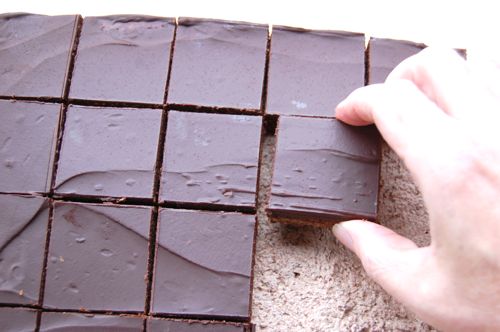
To serve, simply use a sharp knife to cut through the filling and bottom layer. Plate the individual pieces as you like. Edible flowers are nice. This one isn’t I don’t think. You get the idea. I think this cake is best when the pieces have been allowed to sit at room temperature for half an hour or so.
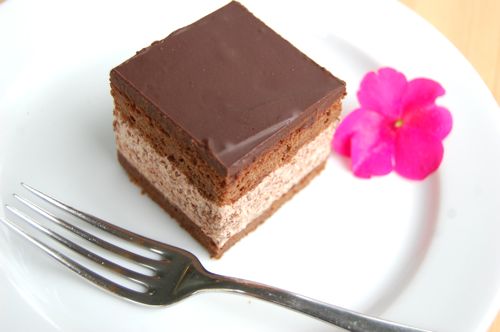
Excuse me now, won’t you? I prefer to eat this cake behind closed doors.
I feel like I need a cigarette after looking at this and I don’t even smoke! Well, no wonder Clara fell for Rigo…it was the cake!
Seewadimsayin’? Thanks Ellen!
this is going to make me crazy! fantastic!!! saliva is dripping out my mouth right here… thanks to this.
There’s only one cure — make it! And let me know how it goes!
I have made rigo joci several time, but the austriam version is a lot more work. I am thrilled to try this recipe. The difference is that i used to put1 cm whipping cream on top of the mouse.It lokka a lot more work bur isnt andit looks great. Try it!
I will, Theresia! Let me know what you think of this…and send pictures!
– Joe
We were lucky enough to have some of this delivered to our house yesterday by Joe.
It was incredible.
Ha! Don’t spread it around — people will start expecting house calls!
next time you’re in Australia mate…
😉
Oh my gosh, this looks absolutely incredible. What an awesome, unusual recipe, thanks for sharing, and I loved the story of Clara and Rigo!! All week I was waiting to see what the cake was going to actually look like… and it is gorgeous. now I want to make it.
Thanks Chelsea! The story really is part of the enjoyment of this cake. Definitely do try it. It’s not as involved as it might appear at first. Having worked out the kinks in the recipe, I can say it’s not a terribly complicated thing.
Thanks for the comment!
– Joe
Wow. Beautiful, very beautiful. Interesting idea, cutting the top layer completely and then placing the cubes on the bottom layer. I can see how that would make life a lot easier. It’s very nice, I love your step-by-step instructions and photos.
Thanks Chana! I went into a little extra detail with the photos this time, mostly because there’s so little that’s published about this cake in English. Continental techniques can seem weird when you haven’t seen them done before, and I wanted to encourage people to try this. For a hundred-year-old recipe it’s quite contemporary in its aesthetic. You can do this in your apartment, no problem!
SO much prettier than my results. Thanks for posting the recipe, Joe! The cake is truly delicious. Maybe I’ll try it again for another upcoming birthday….
You didn’t have the benefit of a decent recipe, and I’m to blame for that. Give it another go and I promise the results will be better. Cross my heart and hope to die!
– Joe
hi joe
i dont know, if Rigo were alive today, i would fall for him, but iwould definitely fall for this cake. You took extra care to post pictures of each and every step. Thanks a bunch. Can i use Lindt 99% cocoa bar instead of the bittersweet chocolate in this recipe.(i am sorry, i am not well versed in chocolate classifications)…
You’d really have to like men with facial hair. But yes, I did record almost every last step, mostly because some of the processes are unusual. Regarding the chocolate, you can use 99% in the cake, which will make it even more coffee-like in its taste. You might want to add a few more tablespoons of sugar to the batter to compensate. I wouldn’t use it in the topping, since that would be too bitter. Let me know how it turns out!
– Joe
hi joe i tried the sponge part. It tasted great,but had the texture of a brownie. Is it meant to be like that…? and for the mousse part, you must remember the cream debacle. I used cool whip instead. It tasted very much better than the other frosted cakes that i make, but cannot decide on the flavour until i taste the original one myself..thanks again.
Brownie, eh? It’s supposed to be quite a bit lighter than that. Keep whipping up those eggs! I do indeed remember the whipping cream problem, but have you tried making mouse? It holds up a lot better than plain whipped cream. You should give it a test run!
eeek how can you use coolwhip for such a sophysticated cake, that,s a sin!
TG
I forgot – I have also frozen this cake. It,s still wonderful when thawed.
Good to know!
– Joe
Sometimes desperate times call for desperate measures. I won’t judge! 😉
– Joe
I am going to Budapest in June and have been anxious to check out Gundel and compare. I,ll let you know what I found. Theresia
Send me a picture as well!
– Joe
Who is Joe? A pastrychef? If so maybe you can simplify the opere cake. It,s another terrific cake. I got the recepy on a cruise ship, but it,s for 200 People Theresia
Hey Theresia!
There’s a recipe for opera on the blog here just look under “Pastry” in the menus to the left!
– Joe
I just found a picture in the hungarian section for rigo jonci. You can see the picture with the white whipped cream on top of the chocolate.It,s beautiful. T.
Thanks, Theresia!
– Joe
Hello…
Love your site! Will you be publishing the recipe for this incredible Rigó Jancsi cake? WOW!!!
Thanks Don! My habit is to put up the recipe and the tutorial in tow different posts. I put up the recipe last week, just scroll down and you’ll see it. Cheers,
– Joe
THIS LOOKS AMAZING!!! I cannot wait to try this
Let me know how it turns out, George!
– Joe
I’m going to try this for my daughter’s birthday — she is a “Death by Chocolate” girl, in love with every triple-chocolate cream and cake dessert ever created (especially with mousse involved). This one could move to the top of the list.
Maybe a drizzle of chocolate syrup and a sparkler or two? (OK, no, she’s not 2, she’s 22, but still…)
Whoa…when it comes to death by chocolate you ain’t kidding! Send me a picture!
Will this recipe
work if the recipe is scaled down by 1/2 or 1/4 ?
Hi Mic!
There great thing about baking recipes is that they can almost always be scaled up or down. They only trouble with taking this recipe down is find a pan of the right size to hold the batter. My inclination would be to make a full portion of the cake, then freeze half of it for late use. Scaling the filling and topping down is no problem. Beset of luck!
– Jim
I have checked your site many times for this recipe. You must have been reading my mind and everyone’s else’s. The recipe is elusive though. Get many descriprions and history of the cake but not many recipes. There is one in the Hungarian Cookbook and the two Fat Ladies made one on their foodie show. Your cake is beautiful and going to make it for family gathering Memorial Day. They will say Mom’s been visiting Joe Pastry again.
Have you done Kolaches yet? Since your are the master of laminated bread doughs, where do I find the recipe for the Olive oil or any oil laminated bread dough. Love your blog, it is always a treat to visit.
Ain’t that the truth? You hear about this cake from time to time but actual recipes are extremely hard to come by. The version I started with came via a Hungarian friend who swore it was from a pastry shop in Budapest. The proportions seemed good, but the processes were all wrong, which made me wonder if there was some sort of problem with the translation…or something. I ended up changing quite a lot about it, including some of the ingredients. I think I came close to the Hungarian version, but who really knows?
To answer your questions, I plan on doing kolache sometime soon, I’ve been wanted to do them for quite a while. Regarding oil and laminated doughs, I’m not aware of there being any. Solid fat is the key to their flakiness. There are margarine laminated doughs, though, is that what you mean?
But thanks for the email and the kind words. Send pictures!
Hi Joe,
I’ve just come across your website and I was very surprised to find the Dobos torta/cake and the Rigo Jancsi recipes! I don’t think there was anything wrong with the translation. I have some Hungarian cake books (in Hungarian) and I have to tell you that the recipes usually don’t work. I’m not sure if that’s because of the different ingredients, such as gluten in flour or fat content in butter and eggs, or because the recipes were not tested. I suppose it’s the latter, since my grandma’s hand written recipes have never disappointed me…
Nice to hear from you, Timea!
I grew up with Hungarians in the Chicago suburbs, so Hungarian pastry is something that’s interested me for a long time. Both of those cakes took a few attempts before I arrived at a recipe I was happy with. Like you, I’m not sure why so many recipes from Hungary don’t seem to work well here, but it’s certainly a combination of differences in the ingredients and testing. A well-tested recipe is a rarity regardless of language. I’ll be interested to hear how mine work for you if you have the time to try them.
Thank you for your note!
– Joe
Hello Joe…
Very pretty and delicious dessert.. I tried my had at it and I’m very pleased with the results. Thank you for the time and effort that it took to prepare the step by step instructions. These were my results.. http://comerio.us/pastry/DSC_1111small.jpg
Bob
Outstanding, Bob! Thanks so much for the pictures. I think your mousse turned out better then mine. It looks more homogenous. Very, very well done.
OK, so I did make this cake. And it was really good, Joe! I made a few small adjustments which may or may not be in the spirit of the cake – I used brown sugar instead of corn syrup in the glaze, and it gave the top a little bit of grit, which I liked. I also like brown sugar and chocolate though. Overall, really tasty. And surprisingly easy – there’s just a lot of bowls to wash, but nothing too difficult in the kitchen. Thanks for sharing! I feel like I might be making this again since it looks elegant and impressive but is, as I said, pretty easy to assemble.
I blogged about it and mentioned your site about a bajillion times 🙂
Great news, Chelsea! Thanks for the note. And brown sugar you say…interesting….
Hello,
Could you please specify for us non-Americans what is the size (in inches or cms) of “a half sheet pan”?
Thanks!
Hello Elle!
The dimensions in inches are in the recipe post, but just to be clear, in the States that pan is just under 33 centimeters by 46 centimeters.
I have a dairy-free mousse I make with coconut milk and to avoid the flakes with that I usually mix it with the chocolate before cooling and then whipping it. Makes for a denser mousse but the flakes aren’t there. could work for this? I don’t know.
I think it would!
I tried this and it worked like a charm! Thanks for posting this recipe-I love it. It’s probably the first chocolate sponge cake I’ve really liked.
Great news, Allison! I appreciate you taking the time to let me know. It’s addictive stuff, ain’t it?
Hi Joe,
I’m throwing a party next weekend and have hired a wonderful gypsy jazz band. This Rigo Jancsi will be the special dessert. Thanks for the great recipe and detailed instructions!
That is an inspired idea, Judy! Well done…have them play some Django for me! 😉
– Joe
Believe it or not rigo jancsi was my great uncle! My great grandmother apparently fled Germany to avoid an arranged marriage, came to the usa married my great grandfather and feared running into rigo every time he performed in NY. She wasn’t afraid of him so much as her parents. I was researching Rigo and discovered the dessert named for he and Clara’s scandalous love! I’m going to make your delicious recipe for a family reunion! I think it will be fun to give the back story and yummy to eat thanks!
Wow! What a great person to have in the family tree! Have fun making the cake, and let me know if you have any questions!
Cheers,
-Joe
I have been making this cake for years. In Europe, a string is used to cut the one layer cake in half. I keep it cold until shortly before serving. I also vary the filling flavors with cognac, Kirsch and coffee liquer.
I love the blissed out chocolate rapture on the faces of those eating it. One man I know ate four pieces in one sitting. He would have had more has there been any left.
Very interesting. The European bakery in my old Chicago neighborhood used to cut their Napoleons and other layered pastries that way: with a wire. A very efficient method I must say. Love the variation on the filling, also. I shall try that!
Thanks for writing in, Barabara. Glad this is working so well for you!
– Joe